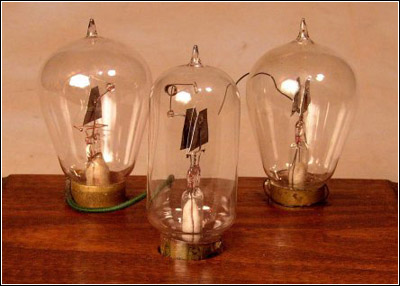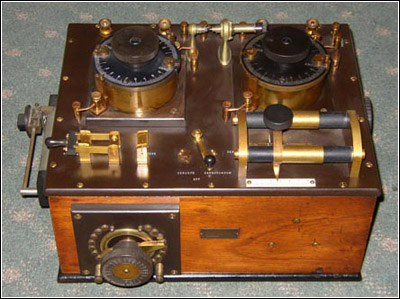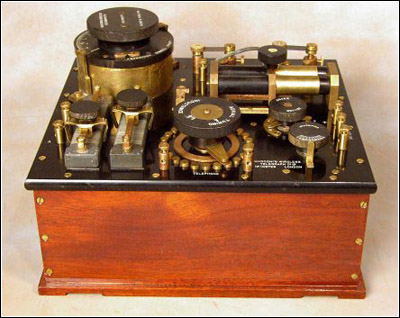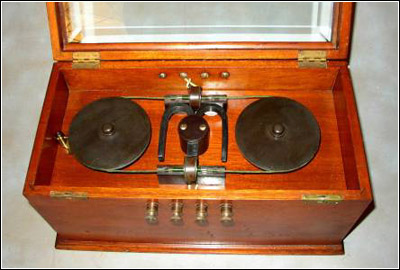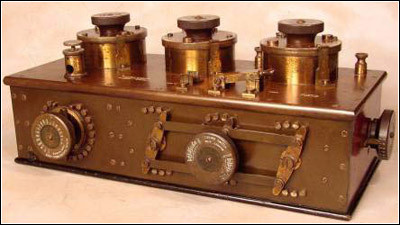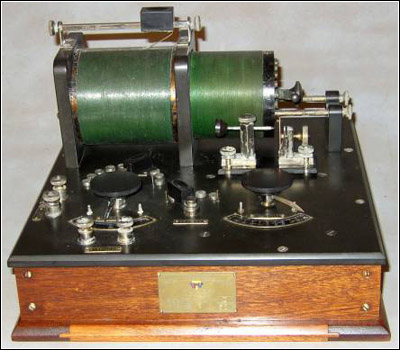Of Old Radios And Related Items--Published Monthly
Wireless at Stone Vintage Radio -- Part 2
By Howard Stone
Web Edition
As promised in Part 1, Howard Stone presents an overview of his prized Marconi sets that can also be viewed on his website. (Editor)
In last month's issue of A.R.C., I discussed several wireless receivers from 1914 to 1919 that may be seen in my virtual museum StoneVintageRadio.com. This month I will again look at wireless sets, but this time all of the sets are made by Marconi. Some were made by the Marconi Company in the U. K. and others by American Marconi.
The story of Marconi, thought by many to be the father of radio, is well known to all serious radio historians and collectors. Born in 1874, he began experimenting with wireless in Italy at an early age. He became fascinated with the work of Heinrich Hertz, and it occurred to him that he could use Hertzian waves to communicate from point to point without wires.
Most researchers in the late 18th century were interested in Hertzian waves purely as a scientific exploration. Marconi found that he had to go to England to get a good hearing for his ideas of wireless communication. Soon he started wireless companies in the U. K. and also in many countries around the world. At first he would not sell his equipment but offered it only for lease. Included here are a few selected pieces of
Figure 1. Three different American Marconi Fleming Valves.Marconi equipment from the collection at StoneVintageRadio.com. (I urge readers not familiar with Marconi and his wireless sets to read J. & F. Kreuzer's "Marconi--The Man and his Apparatus," in Vol. 9 of the AWA Review.)
Fleming Valves, American Marconi
Shown in Figure 1 are three Fleming valves made by the American Marconi company. The Fleming Valve was the first commercial application of the Edison Effect (the flow of electrons through space by a heated element) used as a vacuum tube rectifier/detector. J.A. Fleming developed the tube in 1904. The Fleming Valve is by most accounts the grandfather of the modern vacuum tube.
It is hard to estimate how many of these Fleming valves are still in existence. One knowledgeable authority suggested that there were about 60 in the U. S., about 30 in the U. K. and about 20 or so elsewhere. Shown are three different Fleming Valves. You see two different shapes of glass enclosures. The valve on the left has one plate and the other two have two plates. I assume that the single plate is an earlier version of the valve. The valve on the right has an intact carbon filament.
Figure 2. American Marconi 103 receiver.103 Receiver, American Marconi
The Marconi 103 seen in Figure 2 is an early radio made by American Marconi. It is a crystal set and was made for the most part with English parts. It came out in 1913 and primarily was used on board ships. The frequency it tunes is 200 to 600 meters. Just two years after the 103 was introduced, most were recalled to the factory for a significant change of its circuitry. The result was the more commonly seen Model 107 or 107A. You can tell the difference between a 103 and a 107 because the 107 has a 6-point switch mounted on top of the panel in the center. By changing the tuning circuit of the 103 to the 107, it could now tune 250 to 4,000 meters, according to the J. & F. Kreuzer article mentioned earlier.
Type 16 Crystal Receiver
Around 1918, a ship went down. Although I know nothing about the ship, it must have been a modern ship of its time because it was outfitted with a Marconi wireless station. The receiver was a Marconi Model 16 crystal set first introduced in 1914. It is a 2-crystal detector set; the two detectors can be used for balanced or independent working. The Marconi 16 covers 250 to 3,500 meters.
Figure 4. The restored Type 16 crystal receiver.In 1999, the Model 16 crystal set I have in my collection was brought up from the bottom of the ocean -- along, presumably, with other treasures from the sunken ship. Another collector did some preservation work on the set for three years before turning over the reins to me. He commented, "If I knew what I was getting into, I might not have done it." Many radio historians have echoed those words after they started a preservation project.
Figure 3 (see print version or complete issue PDF) shows the set as I received it. If someone had told me I could restore a radio that had been under the ocean for some eighty years, I would have thought he was crazy! But my wife agreed that I needed a big project that would keep me occupied for a long time. As it turned out, preserving the Marconi 16 has been my most satisfying project in over 35 years of restoring radios. The restored receiver is seen in Figure 4.
I do enjoy preserving radios --even basket cases; in fact, it is the aspect of radio collecting that I value most.
Figure 6. American Marconi magnetic detector.I am neither fond of nor very good at finding sets. When I take a mouse-infested, ratty old shambles of a radio and make it look good again, that is satisfaction. I probably developed this bent to my hobby because, as a teacher married to a teacher, many times I could not afford good clean examples of the sets I wanted. I had Dom Perignon taste on a Tecate budget.
You can read the story of reclaiming the Model 16 crystal set on my website.
Magnetic Detector
Most seasoned radio collectors spend many hours helping antique dealers and others learn about radios. It is in our own interest to have more eyes out there looking for radio gear. When I was teaching at Texas Christian University, every seventh year I was granted research leave -- the first three times in Cambridge, England. As a result, my wife and I have many British friends, among them an antiques dealer who finds items of early technology from time to time. On one research leave (1992-93), he and I were poring over an early book on electrical and wireless technology while we waited for tea. I would point at a picture and say, "If you ever see this, please buy it for me." Tea came, and we put the book aside.
Nine months later, back in Fort Worth, Texas, I received a phone call from England. My friend had found a magnetic detector. Did I want it? My answer, obviously, was yes. When the magnetic detector arrived, it was a little scruffy, but all original. Figure 5 (see print version or complete issue PDF) shows the magnetic detector today.
A little history: In 1895, Ernest Rutherford, a scientist in England, was able to detect signals transmitted a mile away, using a magnetometer, a device used for measuring the strength of magnetic fields. Rutherford's research was based on the prior work of Lord Rayleigh and other scientists studying oscillatory currents. Rutherford attached an antenna to the magnetometer, the received signal deflected the needle of the magnetometer, and, thus, an early "magnetic detector" had been discovered. Marconi further developed the work of Rutherford, and in 1902, he produced his own magnetic detector.
The first "Maggie" (the nickname widely used for the magnetic detector) was installed in the Italian Navy's warship the Carlo Alberto in 1903. Magnetic detectors were very reliable for shipboard communication and were the primary detectors installed on European vessels from 1903 to 1912, replacing coherer type detectors. In fact, because of their reliability, magnetic detectors were used as back-up detectors on many ships into World War I to supplement crystal and later valve detectors. For more information on Marconi magnetic detectors, see the article I wrote for A.R.C. in the June 1999 issue.
American Marconi Magnetic Detector
Most of the Marconi magnetic detectors, like the one discussed above, were manufactured in England. The few built in the United States were produced in Aldene, New Jersey. The Aldene plant did not begin full operations until 1912 when magnetic detectors were already on their way out as valves and crystal detectors came in. The result was that not many were produced, and today, no more than a dozen American versions are known still to exist. My American Marconi magnetic detector is shown in Figure 6.
Printed on the bottom of the drawer of this American Marconi magnetic detector is the date it was made, September 26, 1912. There are several obvious differences in the American Maggie: the hinged lid, the beveled glass top, the shape and number of magnets (two vs. four in the English version), and the inclusion of a drawer. It still functions like the English version.
Figure 7. Multiple tuner.The magnetic detector needed something to tune in the desired frequency and a Mr. C. S. Franklin of the Marconi Company developed the multiple tuner to do just that. It was patented in 1907. My multiple tuner is shown in Figures 7 and 8 (see print version or complete issue PDF).
The multiple tuner was produced for ship or shore installations. The magnetic detector was connected to the terminals marked "detector" on the multiple tuner. With the switch on the multiple tuner set at "tune," the magnetic detector was in series with a condenser that was coupled inductively with another circuit called the "intermediate circuit." This intermediate circuit was coupled with the antenna circuit. Each of these circuits was adjusted to the desired wavelength.
Most Marconi installations from 1907 to 1914 used the multiple tuner and are seen with the magnetic detector in many pictures of early shipboard radio rooms. The three round objects on the top of the tuner are high quality variable condensers. The parallel horizontal bars on the front are for tuning and the large knob on the front left is for varying inductance. By selecting the appropriate taps of the antenna inductance, variocouplers, and variable condensers, the set can cover 80 to 2,600 meters. The multiple tuner worked very well for the time.
Wavemeter Number One
Wavemeters are used to measure the length of transmitted waves; from the wavelength, the frequency of a transmission can be calculated. They were one of the first pieces of test equipment developed at the beginning of radio. In 1906, Marconi introduced the Marconi Wavemeter Number One in England. The first commercial wavemeter that Marconi made, it was used mainly at ship-to-ship and ship-to-shore stations. It typically covered the frequencies of 100 to 800 meters (this particular wavemeter, when introduced, was calibrated to measure from 200 to 1,040 meters).
Figure 10. The United Wireless Type E Tuner.I found this Marconi wavemeter while living in Cambridge, England. It was a basket case. The glue was no longer holding and the cabinet was falling apart at all of the joints. The leather was dried and curled up. The leather strap had to be soaked to soften it and then re-glued to the box on the left end that holds the earphone.
Because the wavemeter was in such poor shape, I was not sure how the finish should look. It did not look like other early Marconi apparatus I had seen. I tried to find one in someone's collection in the United Kingdom with no luck. The Science Museum in London had several later Marconi wavemeters, but not the Number One. I contacted the Marconi archives in England; they replied that they had an example of this wavemeter in their collection but would not let me see it because the archives, at that time, were not open to the public. That was bad news for anyone studying or restoring early wireless.
Finally, I mailed some stain chips and a list of specific questions to the archives and got some answers. I found out what I already suspected: the wood of the case was teak -- not mahogany, oak or walnut as one might expect in radios or wireless equipment, but it certainly makes sense for equipment used on shipboard. Fortunately, about half of the original finish was still there so the rest of the finish could be blended in.
The detector used in the wavemeter is a chunk of crystal wedged in between two 2-inch long pieces of spring brass to the back left of the condenser. The small turned round wood box in the back of the earphone box is for spare crystals. The card in the lid is for calculating the wavelength. Surrounding the card wrapped in black tape is the coil.
United Wireless Type E Tuner
The Type E tuner shown in Figure 10, was manufactured by United Wireless in 1911. In 1912, when Marconi took over United Wireless, the Type E tuner was put out as a Marconi set. Therefore, although this particular set was made by United Wireless before Marconi took the company over, both Marconi and United Wireless Type E tuners exist.
The Type E tuner was the first United Wireless set that had a loose coupler on top of the hard rubber panel. The Type E tuner served as the basic design of the oversized Marconi Type 101 receiver, which incorporated a loose coupler mounted behind the panel and tuned from 100-4,000 meters; it was first supplied to the U.S. Navy in 1914. The loose coupler is of very high quality workmanship. The detector could be detached by loosening the two knurled nuts that hold it in place.
Marconi 4 VA Valve Amplifier
I've never seen a description or data on the Marconi 4 VA, a four-step valve amplifier, but it would be safe to describe it as a 4-tube cascade amplifier using Marconi VT vacuum tubes. Jim Kreuzer suggested that "It would have been among the last products produced by American Marconi, about the same time as the Type 120-121-122 receivers. These are dated 1918 and received the final approval on 10-1-1919, only three weeks before the merger into RCA." (Personal communication, December 29, 2009) Only a few of these sets exist today.
IN Conclusion
I have covered several Marconi wireless pieces in my collection that can be found on the virtual museum at StoneVintageRadio.com. The website features additional Marconi pieces, as well as early tubes, horn speakers, radio advertising, and of course, radios up to the 1950s.
Marconi's genius lay in transforming scientific observations into commercially viable products. I sometimes wonder how fully he understood the science behind his wireless transmitters and receiver, but undeniably he had the vision and energy needed to revolutionize communication. Thanks to Marconi, the world was in touch -- without wires.
Reference:
Kreuzer, J. & F. "Marconi--The Man and his Apparatus," The AWA Review, Vol 9, Bloomfield, NY: 1995.
Stone, Howard. "Marconi Magnetic Detector," Antigue Radio Classified, June 1999.
Howard Stone is Professor Emeritus of Pastoral Counseling at Texas Christian University, Fort Worth, Texas. A longtime collector, he is especially interested in wireless one and two-tube battery sets of the early 1920s, as well as crystal sets. His many articles for A.R.C. include a series on British crystal sets and an article on round Ekcos.
|
[Free Sample] [Books, etc., For Sale] [Subscribe to A.R.C./Renew] [Classified Ads] [Auction Prices] [Event Calendar] [Links] [Home] [Issue Archives] [Book Reviews] [Subscription Information] [A.R.C. FAQ]URL = http://www.antiqueradio.com/Aug10_Stone_Vintage2.html Copyright © 1996-2010 by John V. Terrey - For personal use only. Last revised: July 24, 2010. For Customer Assistance please contact ARC@antiqueradio.com or call (866) 371-0512 toll free Antique Radio Classified |
